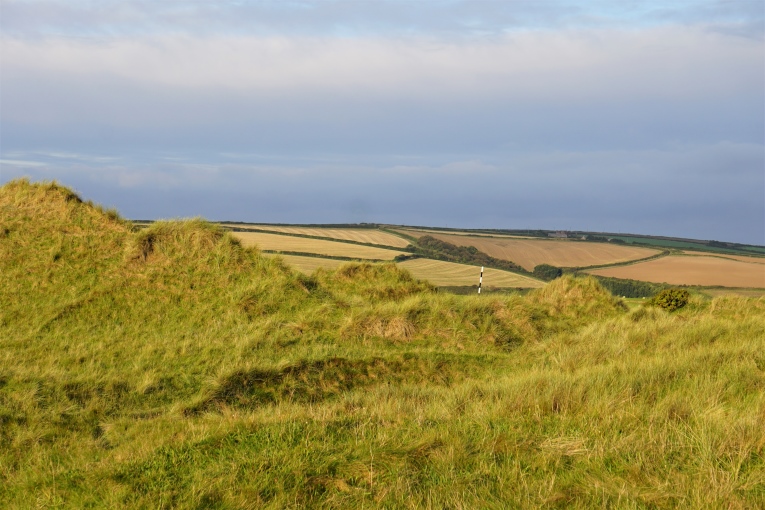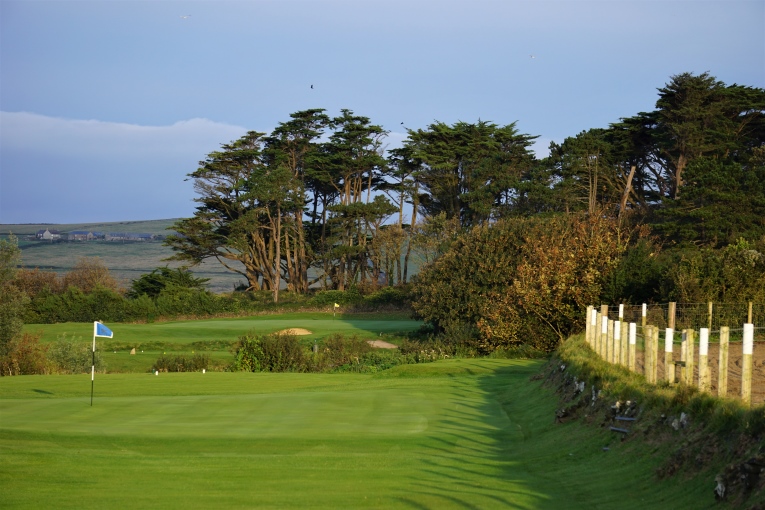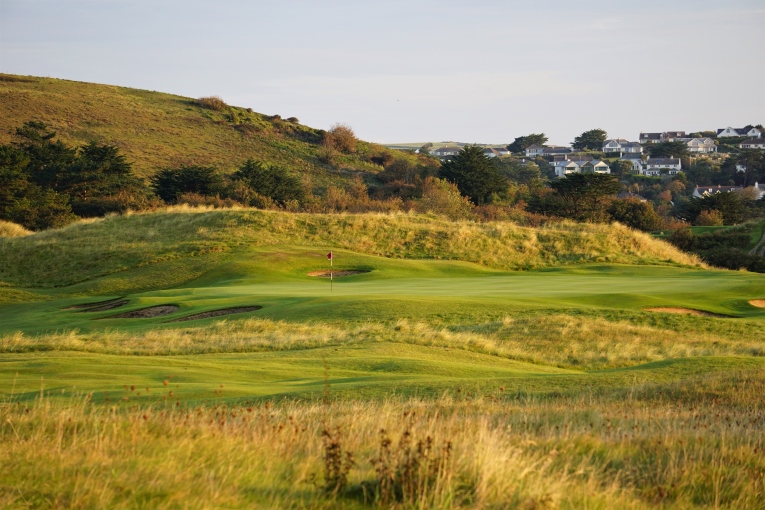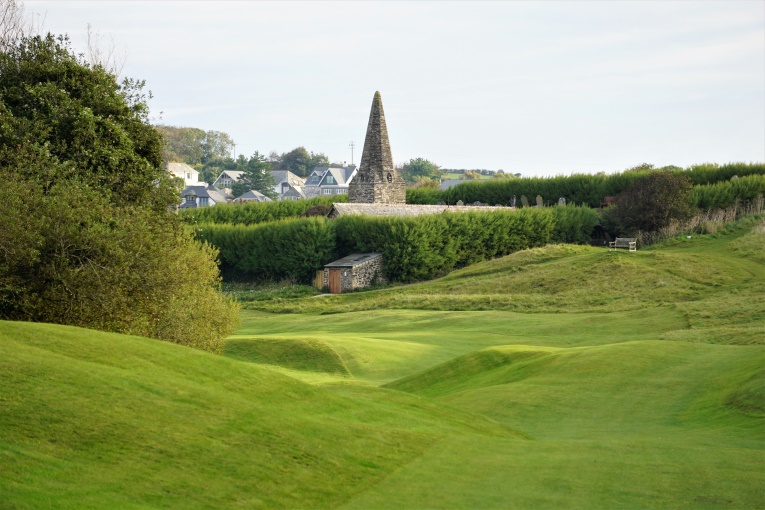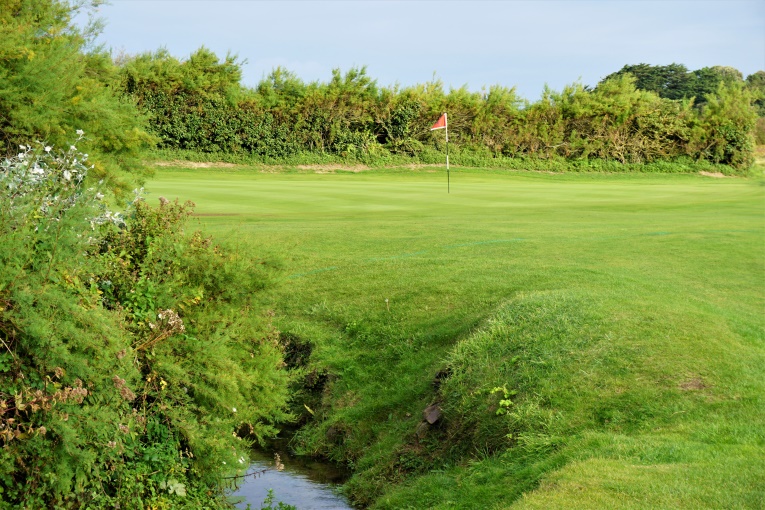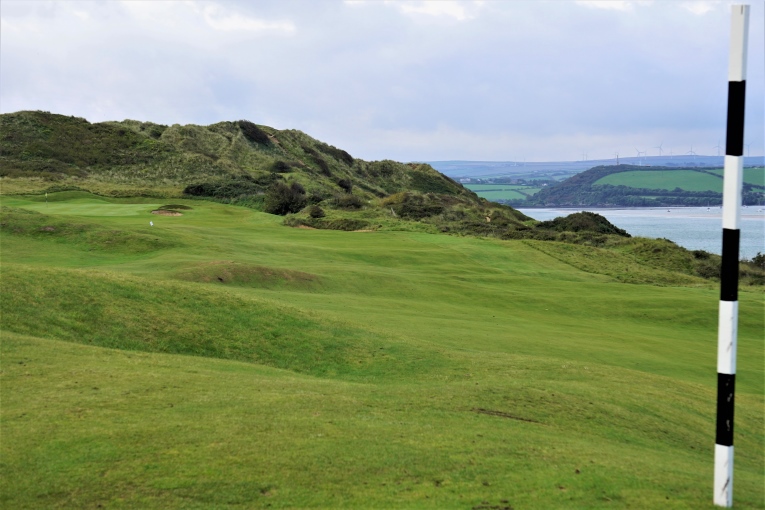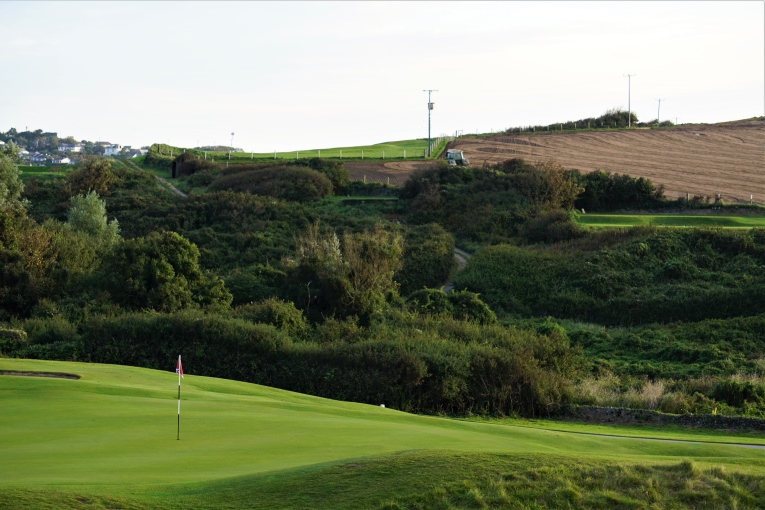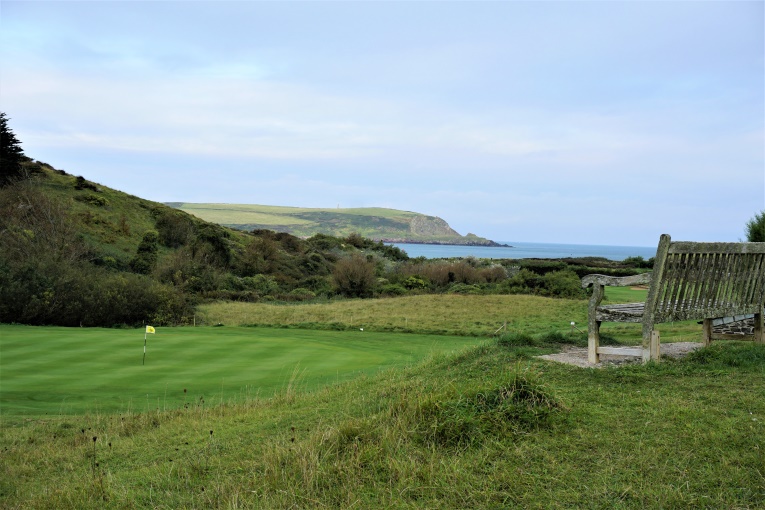St. Enodoc Golf Club (Church Course)
Rock, Cornwall, England
United Kingdom
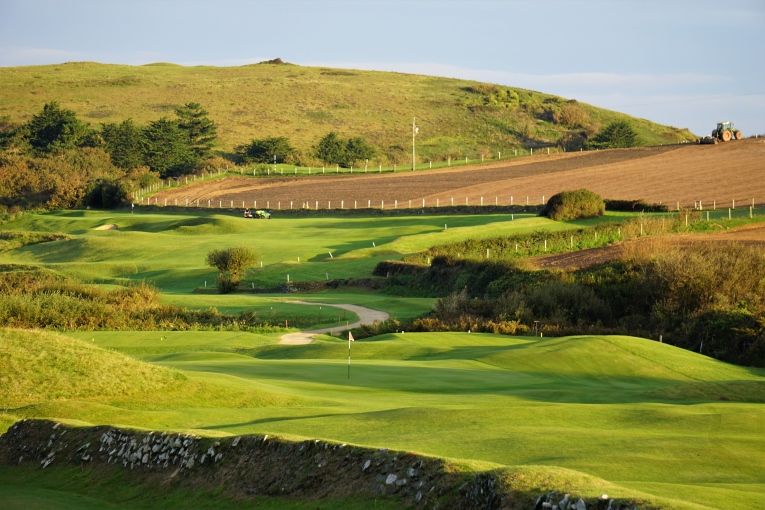
St. Enodoc’s magnificent routing provides a panoply of rich backdrops that lends a game here an enchantment rarely found.
Why is England the author’s favorite country for golf? From a historical perspective, golf course architecture began here. When the game moved inland to be near people’s homes, the most intelligent, thoughtful work to render inland properties appealing to golf occurred first in England. Also, the diversity of the landscape is unmatched, from links to heathland to parkland to upland to moorland. Additionally, England embraces more courses in the 6,100 to 6,600 yard range that the author unreservedly considers ideal and worth emulating than any other country.
One of the jewels in the English Crown is St. Enodoc, a course that many consider to be James Braid’s masterpiece. Locals first played golf on these grounds in 1888 on a nine hole course fashioned around St. Enodoc Church. At the turn of the 20th century, according to the Club’s Course Historian Peter Bendall, the club acquired ~40 acres closer to the estuary. So when Braid was invited by the club in 1907 to expand the course to eighteen holes, he was the first to have the chance to work in the magical dunes land that is now occupied by today’s first, ninth, sixteenth, seventeenth, and eighteenth holes.
Braid ultimately worked on the course in each of the three subsequent decades with his final refinements coming in 1937. As such, St. Enodoc can be considered Braid’s version of Donald Ross’s Pinehurst No. 2 and C.B. Macdonald’s National Golf Links of America in the context that each architect fine-tuned his favorite course over several decades. True, the firm of Fowler & Simpson lent a hand in the early 1920s but it was primarily Braid that thumped so much character into the course.
Situated in Rock, Cornwall across an estuary from Padstow, St. Enodoc occupies one of the game’s most varied and rambunctious properties. Braid’s routing maximally exploited the advantages of its sundry sections. Golfers start high near the clubhouse and water comes into view walking down the crumpled first fairway. By the third, the player is sheltered from such views and the course rubs against the picturesque rolling farmland for which the area is well known. A massive dune line hinders the approach at the sixth and the tee ball at the seventh. Yet, by the ninth, towering Cupressus Macrocarpa trees form the backdrop. The tenth might not even be a hole (!) but standing on the eleventh tee, the Stepper Point headland seen at the first gloriously re-emerges. The golf turns inland and plays beside the aforementioned 12th century stone church that lends the course its name before ascending uphill at the thirteen and fourteen to the course’s high point. The three concluding holes are played across rumpled land framed by dunes.
The author’s brother John goes so far as to pose the question: Do enough people appreciate that this might well be the single finest property for golf in the world? Well – now that’s a point for discussion! In a recent conversation, the two brothers marveled at both the property’s micro and macro features. In terms of micro, one, two and three foot tall features meaningful impact the game here, be it the random fairway contours, or the wall at the third and fourth, or the support wall to the vexing fourteenth green. In terms of macro, one of the game’s grandest bunkers is found here and the long sweeping views in all directions bewitch.
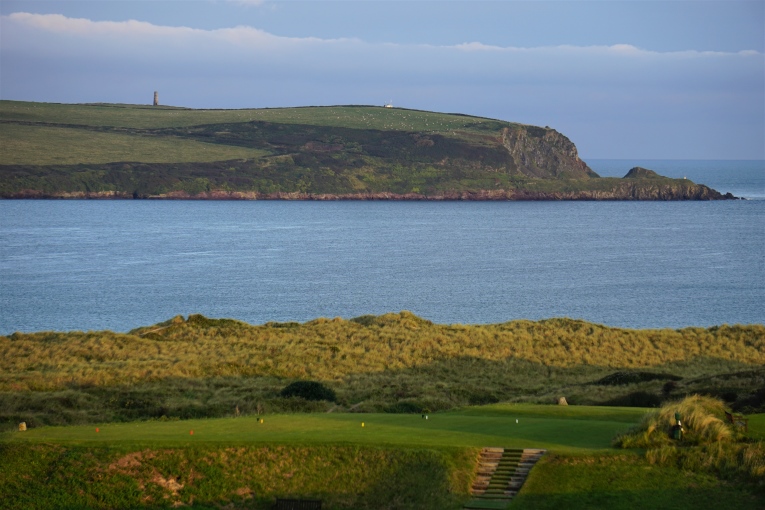
Numerous views of water are afforded throughout the round, and yet no hole is at risk to coastal erosion.
Three of the holes rise and fall by more than 80 ft. (e.g. the third, tenth, and thirteenth) and one (e.g. the fourteenth) plays along a ledge. It’s a rollercoaster ride and yet, it doesn’t take much more than three hours to complete. Some in the United Kingdom compare it to Cruden Bay but in many respects, the brothers think of the course in the same vein as their favorite course on continental Europe: Royal Hague. The never ending twists and turns in both the land and the routing define the pleasure of a round at each. Recently, Royal Hague has climbed in GOLF Magazine’s world top 100 and the brothers are confident the same will happen with St. Enodoc: the golf is that good.
St. Enodoc’s diversity makes it stand out. Several of the author’s favorite links – The Old Course, Brora, Portmarnock – feature eighteen holes ‘cut from the same cloth.’ Their properties are consistent and the player delights in ceaselessly playing across crumpled land. St. Enodoc represents a different brand of golf over ridiculously different and ever-shifting playing fields. The changing environments greatly add to the allure of the place; there is something for everyone.
Ultimately, St. Enodoc obtains the ideal balance between pleasure and challenge. Surely it helped that Braid was there to see the design transition from hickory to steel. After he passed in 1950, the club has made a series of prudent decisions (which includes those all important decisions to do nothing). Fortuitously, they never chased length for its own sake, so the course measures under 6,600 yards. The Brits understand that a club is for the enjoyment of its members and that sort of distance over that sort of land is more than ample for its membership (and their dogs!). True, several holes have been extended (especially the fourth, sixth, eleventh, and sixteenth) but were done so to require shots similar to those in the Golden Age of architecture.
Given its raucous land and stone walls, the course evolution might have easily gone askew. For instance, the seventh hole features a blind drive in the opposite direction over the same dune from which the Himalaya bunker was carved. Given that blind shots have fallen from favor in certain (dull) circles, the club could have decided to ‘alter’ the dunescape and ‘improve’ the visuals. What a tragedy and loss of adventure that would have been. However, as a nod to modern equipment and heeding Peter McEvoy’s advice, two bunkers were added down the left and one down the right so that the tee shot isn’t too freewheeling. It is the best of both worlds: the golfer appreciates an old-fashioned challenge but allowances have been made for the modern game.
Another action that helped the course was pushing the sixteenth green back 60 yards in the fall of 2006. It and the thirteenth are the only greens relocated since Braid’s last work here. This move mitigated the vulnerability of a par 5 built in the Golden Age to the onslaught of technology, especially one that frequently plays downwind like this one. Yes, the Braid green was exquisitely located but it flattered too many players who approached it with a mere mid iron. The green was placed on top of a dune rather than its base and angled just enough to frustrate the tiger.

The 16th green was pushed back and situated high on a dune in 2006. The course’s two three shot holes play in the opposite direction. Similar to the 5th and 14th at The Old Course at St. Andrews, this design ideal is rarely achieved.
Recent enhancements to bunkering schemes that fit the modern game and a renewed dedication to fast and firm playing conditions have pushed the course to the forefront of links golf. Indeed, given how the design pedigree excels, the golfer might wonder why it isn’t a ‘royal’. Perhaps the former Duke of Windsor is to blame? He spent quite a bit of time here, which shows that his good taste wasn’t confined to matters of sartorial excellence. Yet, after abdicating the throne in 1936, the Duke likely sealed the fate of the club and course as being underappreciated back in Buckingham Palace!
Regardless, St. Enodoc’s last four holes comprise one of the most appealing finishing stretches and the first four represent the only start on a links that rivals Royal County Down and National Golf Links of America. In between are found St. Enodoc’s two most infamous holes. A tour of the course highlights the varied backdrops, which enunciate the course’s ever-changing landscapes as we see below.
Holes to Note
First hole, 530 yards; This opener makes any golfer yearn to play. Ironically, it used to be the second hole before today’s stately clubhouse was moved southeast 400 yards to today’s commanding position. The clubhouse re-location was driven (no pun intended!) by the acceptance of the automobile and the resulting need for parking. Back on the course, humpy-bumpy land stretches in all directions, creating a vista of pure golf. The four longest holes (here, ten, sixteen, and Home hole) have no prayer of going their distance without dropping and bobbing and/or having a shoulder of a dune intrude into the proceedings. So good is the land that a stone marker is required to point the way off the tee and a black and white 150 yard pole is perched just before another significant stair step down in the first fairway. Braid saw no reason to employ bunkers down the length of the hole or at the green site.
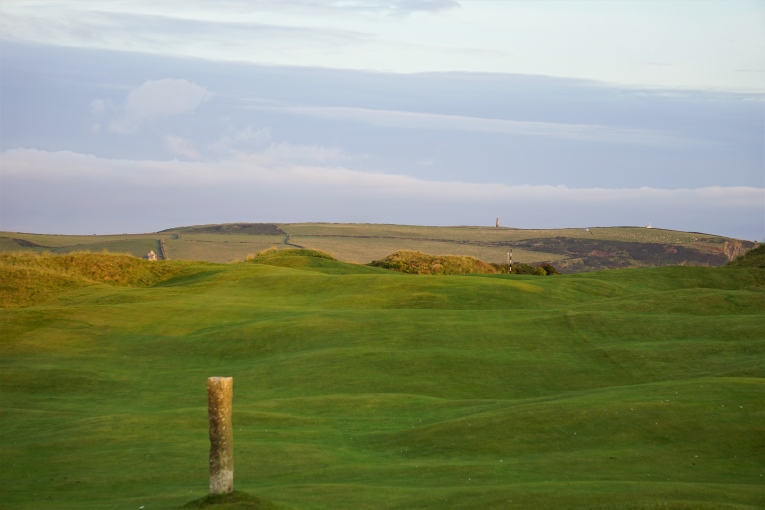
The drive flies over the first post and the distant black and white marker helps orient the golfer for his second.
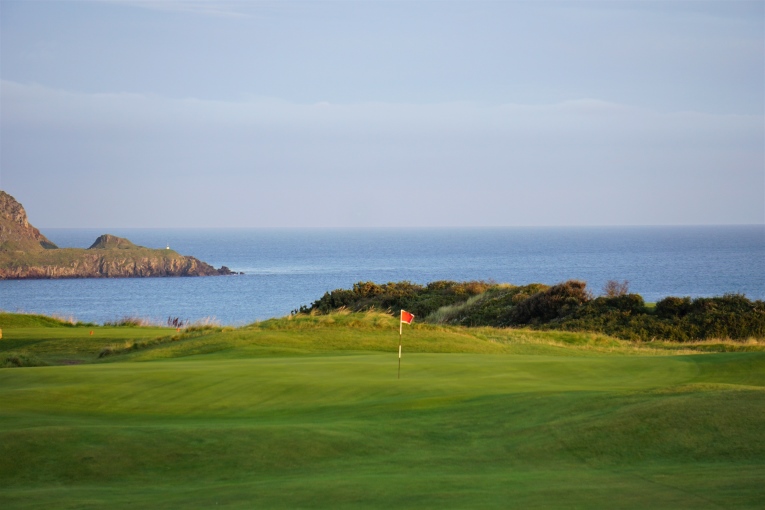
St. Enodoc is the real deal where the ground game plays a crucial role. The absence of bunkers enhances the gorgeous simplicity of the first green.

Speaking of micro contours, note the graceful sweep and transition from the fairway to the putting surface.
Second Hole, 450 yards; The author previously played St.Enodoc only once, in 1999. Two takeaways from the 2017 visit: the course from an agronomic point of view was immeasurably superior, the turf firmer and faster. Congratulations to Green Keeper Scott Gibson and his crew and to the club for having John O’Sullivan, one of Europe’s top agronomists, consult on a regular basis. Secondly, what kind of dolt could ever forget the second hole?! How that came to pass I know not for it is top drawer. The left section of the fairway offers the best (i.e. more level) stances. Braid built the course’s deepest greenside bunker at the right front base of the green and the thought of escaping from it with a niblick leads to no happy conclusion.

Luscious random contours in the 2nd fairway make it clear why links is the highest form of golf. The yellow flag stands at attention on the plateau green.

Among the dazzling long views at St. Enodoc is this scene across the 2nd green and out to Stepper Point.
Third hole, 440 yards; Just as one goes to North Berwick to experience unique challenges, aficionados flock to St. Enodoc where the third and fourth holes exemplify golf you are unlikely to find elsewhere. The course possesses a slew of holes that accurately could be described as par 4 1/2s – this is the third in a row! A long time admirer, golf course architect and critic Tom Doak stopped in for another visit in 2016. He suggested that several of the circular/oval greens could be expanded in the corners to add a few more interesting peripheral hole locations. As an example, this green was soon expanded in the front and a new, fiendish back left hole location was restored as well.
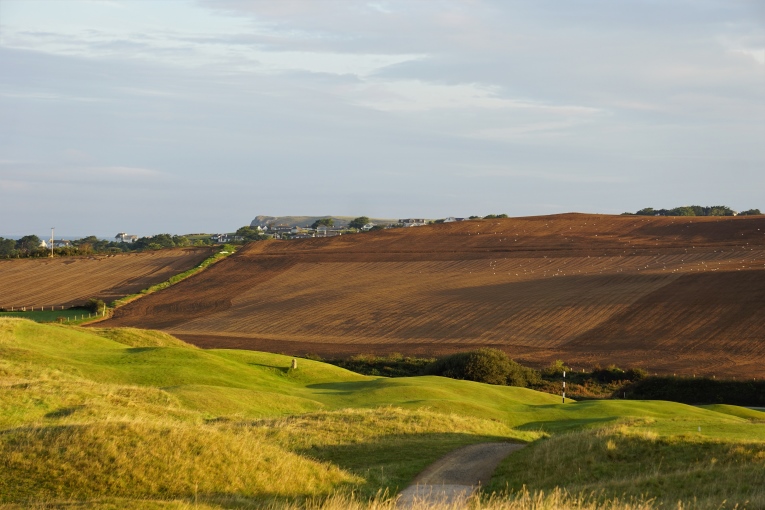
The 3rd cascades downhill along the eastern perimeter of the property. It is bisected by the beach road 300 yards from the tee.
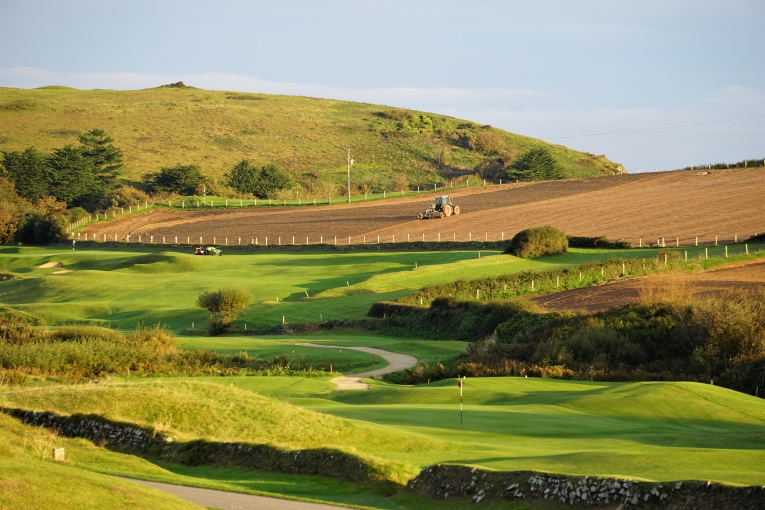
Braid was slower than other Golden Age architects to employ bunkers. The bunkerless 3rd joins the 1st and 10th as superb examples of using other means to establish playing interest. Again, note how the green is at grade with the surrounds, making a running shot a genuine option.

Looking back up the convoluted landforms that comprise the 3rd fairway, it’s hard to believe that this is the most inland part of the Church Course.
Fourth hole, 325 yards; A flawless hole, in the same league as the fourth at Woking, where every golfer can appreciate the genius of man. So glowing is this design marvel that one must wonder if Braid has ever received his proper due among the Golden Age greats. Certainly, the Braid Society and the efforts of John Moreton through his writings have helped spotlight Braid, the golf course architect. Moreton notes in his August 2014 Feature Interview on GolfClubAtlas that many of Braid’s commissions were for private clubs and that Braid never took the ability of the golfer for granted. Braid could have easily built courses that only The Great Triumvirate (J.H. Taylor, Harry Vardon and Braid) would have enjoyed – but he didn’t. Hence, his courses possess a fine mix of holes including this short two shot pearl that measured less than 280 yards in his day. All sorts of trouble is found on the direct line to the hole from the tee and it takes a special player to aim away from the flag and play smartly to the outside of the dogleg. Should someone struggle to understand how/why a sub 6,600 yard course is among the world’s elite, they need look no further than this hole for edification.
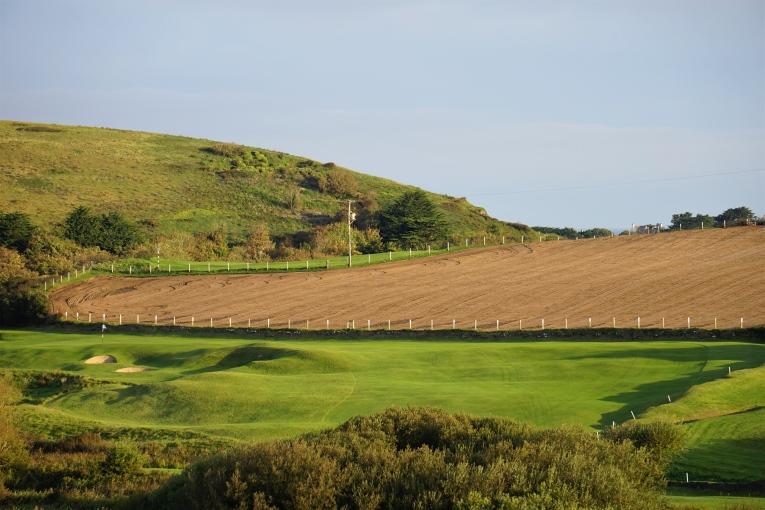
Playing angles and a valid risk reward proposition make the hole thrilling. A courageous tee ball over the out of bounds and into the far corner of the club’s property leaves this …
Sixth hole, 430 yards; A new back tee 50 yards behind Braid’s tees restores some of the terror that golfers felt in the age of hickory golf. One of the game’s most renowned hazards soaks up all the attention but the author thinks the green complex punched into the dunescape is just as noteworthy. It and seventeen are two examples of greens that reward ‘thrusting’ while other greens like the upturned saucers at the first and twelfth reward ‘parrying.’ All great designs have shifting challenges that place an onus on the golfer to determine when to attack and when to be prudent.
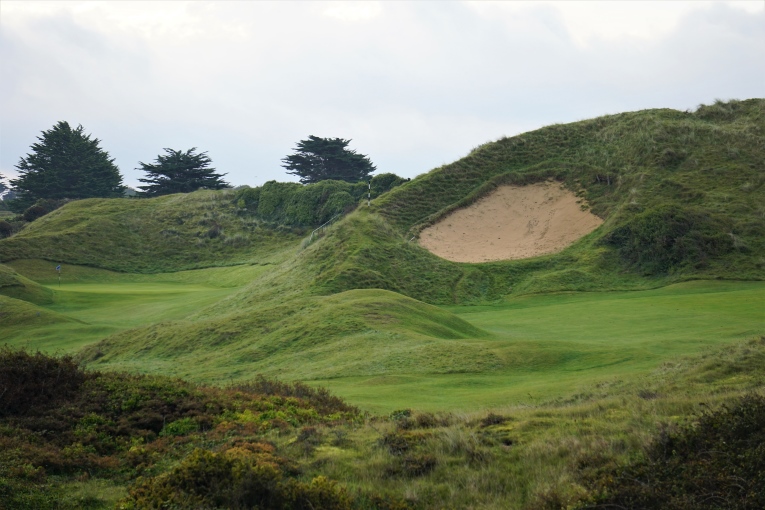
Even into the sun, the monstrous Himalaya bunker photographs well. It is located 90 yards from the green.
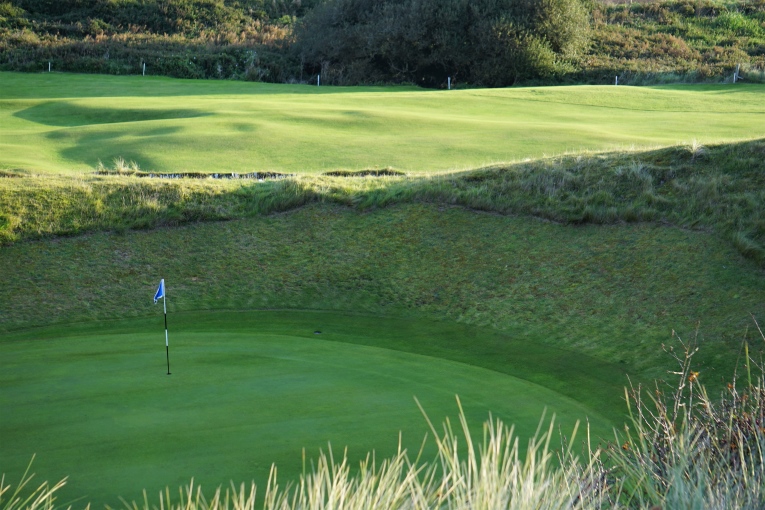
Alister MacKenzie had a way of encouraging/rewarding the golfer for bold play. Same too for Braid with this ¾ punchbowl green where an attacking shot is often times rewarded by a friendly shove back onto the putting surface.
Eighth hole, 165 yards; Seven bunkers make this hole, yard for yard, the most heavily bunkered hole on the course. And sure enough, there is a reason for this shift in design ethos. In 1922, Fowler & Simpson consulted on several alterations and according to Bendall, this brand new hole was created by the removal of a hole from the loop a few holes ahead near Daymer Bay. Those who sniff that The King’s Course at Gleneagles is Braid’s finest effort perhaps do so in part because Fowler & Simpson touched three of the five one shotters at St. Enodoc to one degree or another.

Bunkers across the course are more uniform and crisply presented than in the past. The revetting was accomplished in house and a pride in authorship is evident.
Ninth hole, 395 yards; Central features are much more interesting than features that tag along haplessly to the side. St. Enodoc proves that time and time again. Mind you, a central hazard need not be a bunker and Braid’s designs generally eschew such features. Here, a lumpy dune line bisects the fairway 100 yards from the green. Drive too close, and the 13 foot landform obstructs a view of the green.
Tenth hole, 455 yards; So starts the Loop, six holes play clockwise around the slate-roofed St. Enodoc Church before the fifteenth green returns the golfer to within 60 yards of the tenth tee. Given the plethora of outstanding holes both before and after this stretch, the author would find it surprising if this was someone’s favorite run of holes. Nonetheless, the combination of awkward and unconventional holes make it the course’s most difficult stretch and if someone disparages the Loop, the author would like to know how he played it to better judge the source of any venom. While the loop may contain the least attractive holes (twelve and thirteen), players still relish playing this group of holes because of the variety of terrain and incredible views in every direction (including of the church). Sean Arble penned one of his exemplary profiles on St. Enodoc, which can be read here. He notes regarding the notorious tenth:
What better place to have a controversial hole than one which often requires a wait due to the public footpath. I find it most interesting to listen to the debate on the tee. There is rarely consensus as to integrity of the hole or how to best tackle its challenges. I will defend the old girl if one is harsh in judgment and as St Enodoc’s sole surviving original hole the 10th is surely an old girl. The more I play it, the more I am convinced it deserves a spot on the St Enodoc shelf of exceptional holes. Is the 10th unfair as many seem to charge? To be frank, I don’t think the answer to that question has any bearing on the merits of this hole or any other, but I will say the 10th is a hole that will not soon be forgotten.
To the author, the tenth fairway looks like rapids sloshing from side to side against the walls of a canyon.
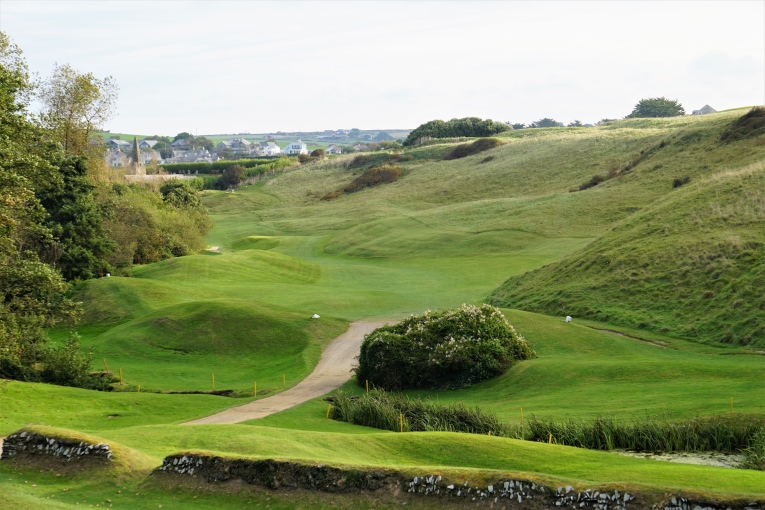
What guts it took for the locals to squeeze a fairway between a burn left and towering dunes right, knowing they would have to tackle it with hickories and a gutta-percha ball! For the modern player, the fairway width drops in half 230 yards off the tee, so mindlessly reaching for the driver on the tee is not a given.
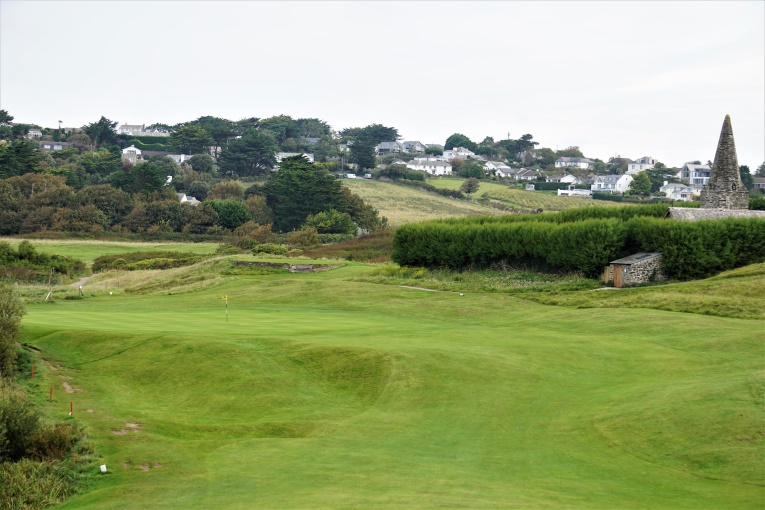
Eventually, the target emerges into view. Again, the land is so feature rich that no bunkers were required and the 10th represents the course’s third and final bunkerless hole.
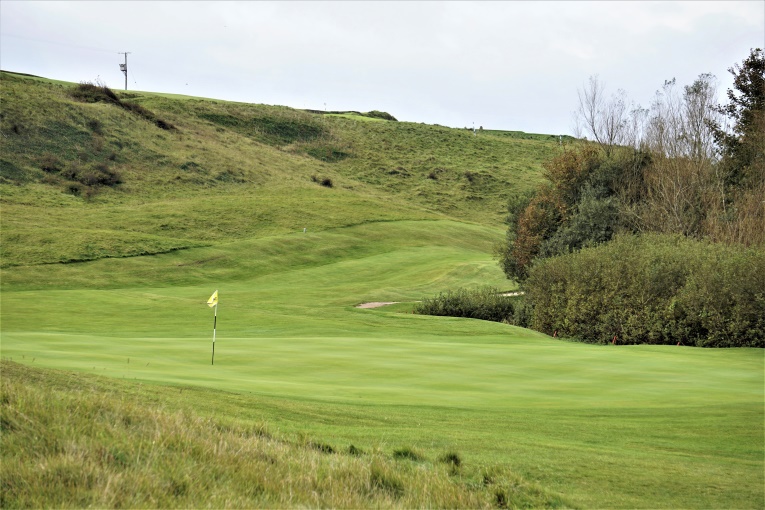
As seen from behind, the angle of the green is most receptive to a drawn approach shot that perhaps lands as far as 20 yards from the green before scooting downhill and onto the putting surface.
Eleventh hole, 230 yards; There are big one shotters that are hard (e.g. Carnoustie sixteen) and big one shotters that are hard and pretty (e.g. Ballybunion fifteen). This hole falls in the latter camp and to be clear it is shockingly difficult. A burn and out of bounds are a mere eight paces off the green’s left edge and behind. As a test of skill and courage, it reminds the author of the old Dowie hole at Royal Liverpool: flirt with the out of bounds and be rewarded; bail right and be confounded by a pair of bunkers. Again, let’s give the firm of Fowler & Simpson their due as Braid’s tee was closer to today’s twelfth tee. Simpson in particular a-d-o-r-e-d both Hoylake and the terror of out of bounds, so no surprise to find that element here. This hole combined with the tenth creates a formidable one-two punch that provides the course with more bite than many courses that blandly measure 10% longer.
Fourteenth hole, 380 yards; A slippery hole to play consistently well, fourteen tip-toes along the high portion of the property so that whatever wind is about is most forcibly felt here. Death is right where the tenth fairway sits some 130 feet below but the canted left to right fairway allows the golfer to aim well away from the abyss. Nonetheless, the approach will likely be played with the ball below one’s feet and that makes the three foot stone wall along the right base of the green complex even more diabolical.
Fifteenth hole, 170 yards; The golfer’s pride might not be as fully intact as it was fifty minutes earlier on the nearby tenth tee but the view across the valley and beach access road has an undeniably restorative effect. Braid’s greens are typically oval, almost circular and this green highlights how the shoulders of his greenside bunkers can make their presence felt well into the putting surface.
Sixteenth hole, 560 yards; The author doesn’t know if Pete Dye was ever here but it sure feels like it. St. Enodoc features a reachable three shotter, a tough one shotter and a strong two shotter as its finishing kick à la Dye’s most famous designs like The Ocean Course at Kiawah, Whistling Straits and TPC Stadium. While the club’s decision to move the green on top of the dune in 2006 versus Braid’s position at its base wasn’t necessary, it was brave. There was clearly ‘execution risk’ in that the work could look disparate from the rest of the course but the club felt that ‘par’ should have integrity. After a decade of play, it is fair to say that this green now feels like it belongs.
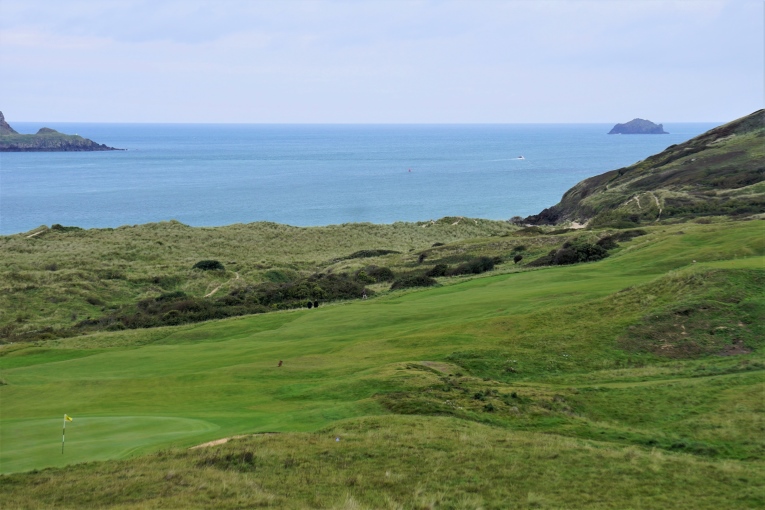
As seen from high left looking back, the 16th fairway twists and turns and the golfer is challenged to remain in position on the course’s longest hole.
Seventeenth hole, 205 yards; Standing on the tee, the golfer can be excused for asking himself how this 6,557 yard course has made him hit so many blasted long clubs into greens! The penultimate hole actually looks a tinge harder than it plays as the green is in a soft depression and balls gather onto the putting surface from its sides. Still, a par is very tidy golf.
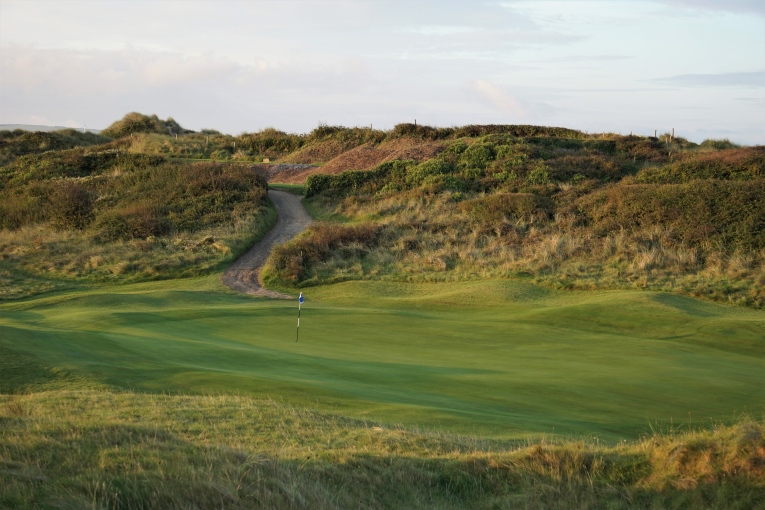
Such a bowled out green site can only be built on sandy soil. Braid amended this hole from a two shotter to a one shotter in 1937 when the clubhouse was moved to its current location.
Eighteenth hole, 470 yards; Many of the game’s finest finishing holes have one common denominator: they are 1/2 par holes. Some are on the easy side (North Berwick, The Old Course, Castle Stuart, Pebble Beach) but others are difficult (Winged Foot West, Merion, Oakmont, Royal Lytham & St. Annes). We all know into which camp the Home hole at St. Enodoc falls! Hitting from a humpy-bumpy stance, controlling the flight of one’s ball and covering a great distance through the wind is the quintessential question that links golf poses better than any other form of golf. The true golfer as opposed to the range jockey who cherishes his level stances will respond to that query by recognizing St. Enodoc’s Home hole as a fitting conclusion to one of the game’s most intriguing examinations. Not only does the hole add an exclamation mark to the round but the 360 degree view from the white tee of the course, estuary and sea is one of those glorious spots where you are freshly reminded just how fortunate you are and how good life is.
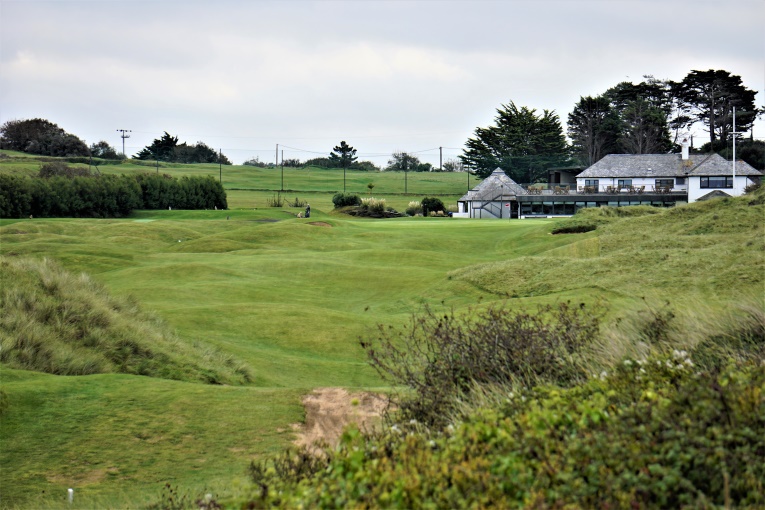
Man’s handiwork can never compete with such natural landforms and the view from the 18th tee reinforces the fact that St. Enodoc occupies one of the game’s most sumptuous properties. Thankfully, the club acquired this area just before Braid was invited to consult. Once here, Braid knew how to maximize the potential and his last modifications to this hole occurred thirty years (!) after his initial work.

This target is all the more difficult to find given that one’s stance is bound to be a bit dodgy. The clubhouse offers everything required to sooth the player’s bruised ego.
Hard to imagine anyone not being duly impressed by the overall environment. Certainly, Cornwall continues to capture the fancy of the world through recent television offerings like Poldark and Doc Martin that show off its irregular coastline. Yet golfers come for the golf and it is the greens at St. Enodoc and the myriad of questions posed by them and their surrounds that elevate the course to a golfing ideal. Some are at grade, others are across ravines, some are on knobs, a couple are on steeper plateaus, one seems in a dune, another is on a wall, one is heavily bunkered and many more than that have no bunkers. Cumulatively, the eighteen targets appeal as much as any set in links golf (admittedly, an audacious statement but the author has huge bias to well placed green sites that render bunkers superfluous and St. Enodoc enjoys five (!) such bunkerless green complexes). Some will disagree but nonetheless, the author puts this set as comparable in overall quality to the likes of those at The Old Course, Ballybunion, North Berwick, Prestwick, Deal and Macrihanish.

… or whether it is situated on a gentle rise and features potato chip waves like the 12th, the greens at St. Enodoc allow all classes of golfers to have fun while still keeping them on their toes.
Visitors play from the yellow tees which measure around 6,110 yards against a tight par of 69 and the golfer will be astounded how he hits every club in his bag. In fact, the overwhelming thought after having played such thrilling golf, so quickly is why do so many other courses take so much longer to play while offering so much less? The author is reminded of a dinner he recently attended where a gentleman remarked to another, ‘I have never heard someone use so many words to express such tiny thoughts.’ Using St. Enodoc as a benchmark, the golfer ponders something similar: why do bloated modern courses offer so little compared to Braid’s timeless effort?
The End
St. Enodoc Golf Club
Rock, Cornwall, England
United Kingdom
Ninth hole, 395 yards; Central features are much more interesting than features that tag along haplessly to the side. St. Enodoc proves that time and time again. Mind you, a central hazard need not be a bunker and Braid’s designs generally eschew such features. Here, a lumpy dune line bisects the fairway 100 yards from the green. Drive too close, and the 13 foot landform obstructs a view of the green.
Tenth hole, 455 yards; So starts the Loop, six holes play clockwise around the slate-roofed St. Enodoc Church before the fifteenth green returns the golfer to within 60 yards of the tenth tee. Given the plethora of outstanding holes both before and after this stretch, the author would find it surprising if this was someone’s favorite run of holes. Nonetheless, the combination of awkward and unconventional holes make it the course’s most difficult stretch and if someone disparages the Loop, the author would like to know how he played it to better judge the source of any venom. While the loop may contain the least attractive holes (twelve and thirteen), players still relish playing this group of holes because of the variety of terrain and incredible views in every direction (including of the church). Sean Arble penned one of his exemplary profiles on St. Enodoc, which can be read here. He notes regarding the notorious tenth:
What better place to have a controversial hole than one which often requires a wait due to the public footpath. I find it most interesting to listen to the debate on the tee. There is rarely consensus as to integrity of the hole or how to best tackle its challenges. I will defend the old girl if one is harsh in judgment and as St Enodoc’s sole surviving original hole the 10th is surely an old girl. The more I play it, the more I am convinced it deserves a spot on the St Enodoc shelf of exceptional holes. Is the 10th unfair as many seem to charge? To be frank, I don’t think the answer to that question has any bearing on the merits of this hole or any other, but I will say the 10th is a hole that will not soon be forgotten.
To the author, the tenth fairway looks like rapids sloshing from side to side against the walls of a canyon.

What guts it took for the locals to squeeze a fairway between a burn left and towering dunes right, knowing they would have to tackle it with hickories and a gutta-percha ball! For the modern player, the fairway width drops in half 230 yards off the tee, so mindlessly reaching for the driver on the tee is not a given.

Eventually, the target emerges into view. Again, the land is so feature rich that no bunkers were required and the 10th represents the course’s third and final bunkerless hole.

As seen from behind, the angle of the green is most receptive to a drawn approach shot that perhaps lands as far as 20 yards from the green before scooting downhill and onto the putting surface.
Eleventh hole, 230 yards; There are big one shotters that are hard (e.g. Carnoustie sixteen) and big one shotters that are hard and pretty (e.g. Ballybunion fifteen). This hole falls in the latter camp and to be clear it is shockingly difficult. A burn and out of bounds are a mere eight paces off the green’s left edge and behind. As a test of skill and courage, it reminds the author of the old Dowie hole at Royal Liverpool: flirt with the out of bounds and be rewarded; bail right and be confounded by a pair of bunkers. Again, let’s give the firm of Fowler & Simpson their due as Braid’s tee was closer to today’s twelfth tee. Simpson in particular a-d-o-r-e-d both Hoylake and the terror of out of bounds, so no surprise to find that element here. This hole combined with the tenth creates a formidable one-two punch that provides the course with more bite than many courses that blandly measure 10% longer.
Fourteenth hole, 380 yards; A slippery hole to play consistently well, fourteen tip-toes along the high portion of the property so that whatever wind is about is most forcibly felt here. Death is right where the tenth fairway sits some 130 feet below but the canted left to right fairway allows the golfer to aim well away from the abyss. Nonetheless, the approach will likely be played with the ball below one’s feet and that makes the three foot stone wall along the right base of the green complex even more diabolical.
Fifteenth hole, 170 yards; The golfer’s pride might not be as fully intact as it was fifty minutes earlier on the nearby tenth tee but the view across the valley and beach access road has an undeniably restorative effect. Braid’s greens are typically oval, almost circular and this green highlights how the shoulders of his greenside bunkers can make their presence felt well into the putting surface.
Sixteenth hole, 560 yards; The author doesn’t know if Pete Dye was ever here but it sure feels like it. St. Enodoc features a reachable three shotter, a tough one shotter and a strong two shotter as its finishing kick à la Dye’s most famous designs like The Ocean Course at Kiawah, Whistling Straits and TPC Stadium. While the club’s decision to move the green on top of the dune in 2006 versus Braid’s position at its base wasn’t necessary, it was brave. There was clearly ‘execution risk’ in that the work could look disparate from the rest of the course but the club felt that ‘par’ should have integrity. After a decade of play, it is fair to say that this green now feels like it belongs.

As seen from high left looking back, the 16th fairway twists and turns and the golfer is challenged to remain in position on the course’s longest hole.
Seventeenth hole, 205 yards; Standing on the tee, the golfer can be excused for asking himself how this 6,557 yard course has made him hit so many blasted long clubs into greens! The penultimate hole actually looks a tinge harder than it plays as the green is in a soft depression and balls gather onto the putting surface from its sides. Still, a par is very tidy golf.

Such a bowled out green site can only be built on sandy soil. Braid amended this hole from a two shotter to a one shotter in 1937 when the clubhouse was moved to its current location.
Eighteenth hole, 470 yards; Many of the game’s finest finishing holes have one common denominator: they are 1/2 par holes. Some are on the easy side (North Berwick, The Old Course, Castle Stuart, Pebble Beach) but others are difficult (Winged Foot West, Merion, Oakmont, Royal Lytham & St. Annes). We all know into which camp the Home hole at St. Enodoc falls! Hitting from a humpy-bumpy stance, controlling the flight of one’s ball and covering a great distance through the wind is the quintessential question that links golf poses better than any other form of golf. The true golfer as opposed to the range jockey who cherishes his level stances will respond to that query by recognizing St. Enodoc’s Home hole as a fitting conclusion to one of the game’s most intriguing examinations. Not only does the hole add an exclamation mark to the round but the 360 degree view from the white tee of the course, estuary and sea is one of those glorious spots where you are freshly reminded just how fortunate you are and how good life is.

Man’s handiwork can never compete with such natural landforms and the view from the 18th tee reinforces the fact that St. Enodoc occupies one of the game’s most sumptuous properties. Thankfully, the club acquired this area just before Braid was invited to consult. Once here, Braid knew how to maximize the potential and his last modifications to this hole occurred thirty years (!) after his initial work.

This target is all the more difficult to find given that one’s stance is bound to be a bit dodgy. The clubhouse offers everything required to sooth the player’s bruised ego.
Hard to imagine anyone not being duly impressed by the overall environment. Certainly, Cornwall continues to capture the fancy of the world through recent television offerings like Poldark and Doc Martin that show off its irregular coastline. Yet golfers come for the golf and it is the greens at St. Enodoc and the myriad of questions posed by them and their surrounds that elevate the course to a golfing ideal. Some are at grade, others are across ravines, some are on knobs, a couple are on steeper plateaus, one seems in a dune, another is on a wall, one is heavily bunkered and many more than that have no bunkers. Cumulatively, the eighteen targets appeal as much as any set in links golf (admittedly, an audacious statement but the author has huge bias to well placed green sites that render bunkers superfluous and St. Enodoc enjoys five (!) such bunkerless green complexes). Some will disagree but nonetheless, the author puts this set as comparable in overall quality to the likes of those at The Old Course, Ballybunion, North Berwick, Prestwick, Deal and Macrihanish.

… or whether it is situated on a gentle rise and features potato chip waves like the 12th, the greens at St. Enodoc allow all classes of golfers to have fun while still keeping them on their toes.
Visitors play from the yellow tees which measure around 6,110 yards against a tight par of 69 and the golfer will be astounded how he hits every club in his bag. In fact, the overwhelming thought after having played such thrilling golf, so quickly is why do so many other courses take so much longer to play while offering so much less? The author is reminded of a dinner he recently attended where a gentleman remarked to another, ‘I have never heard someone use so many words to express such tiny thoughts.’ Using St. Enodoc as a benchmark, the golfer ponders something similar: why do bloated modern courses offer so little compared to Braid’s timeless effort?
The End


